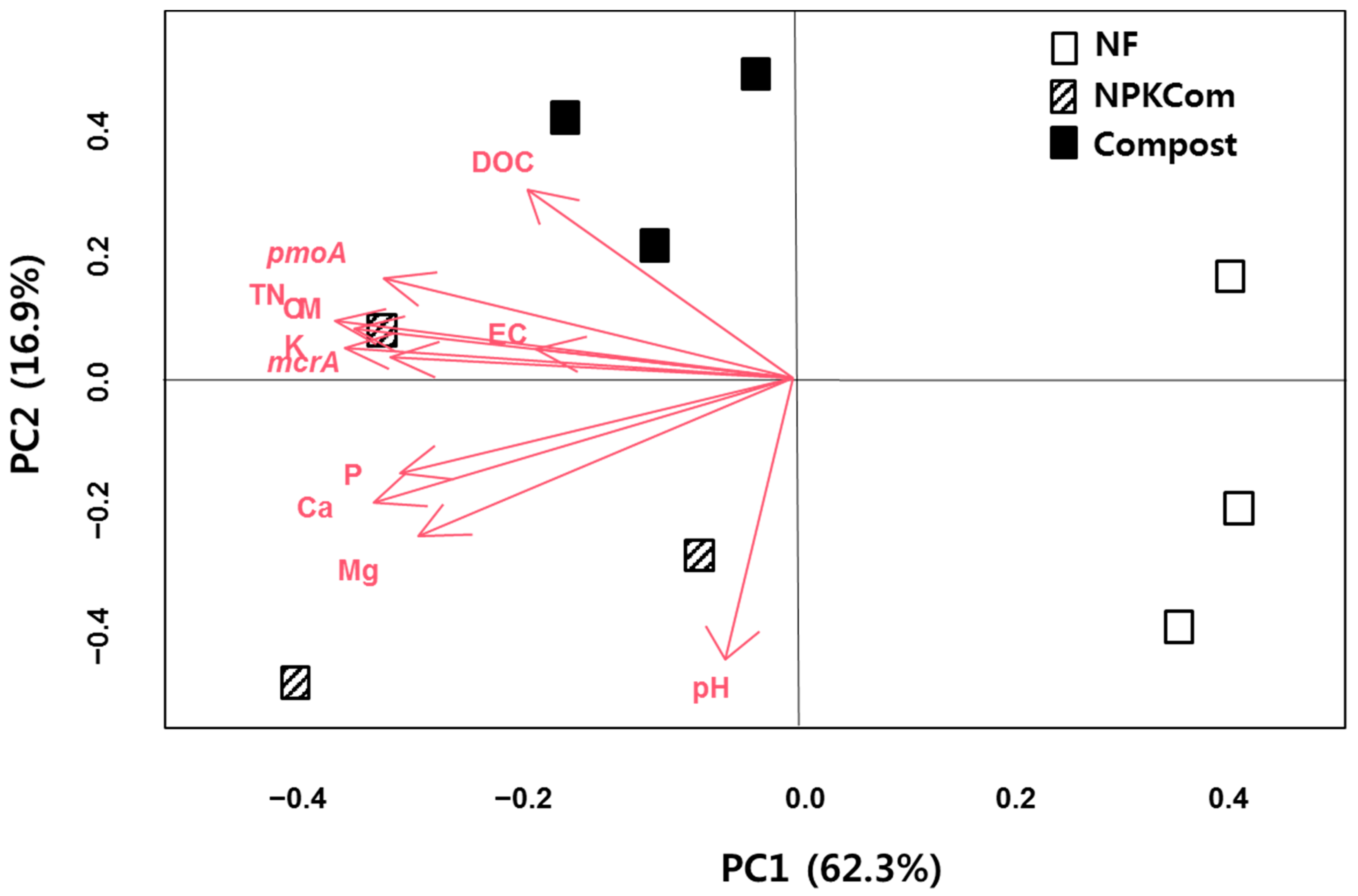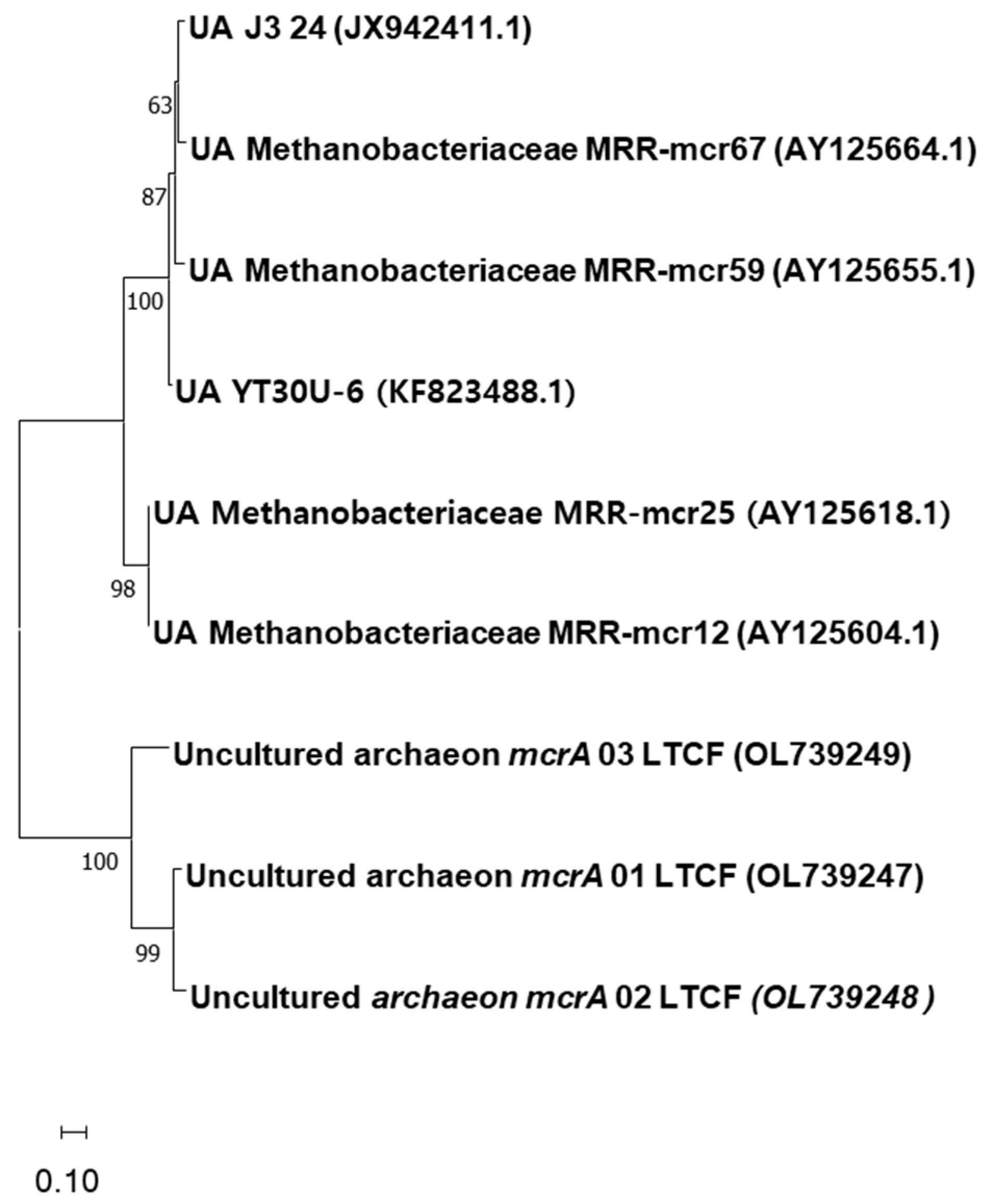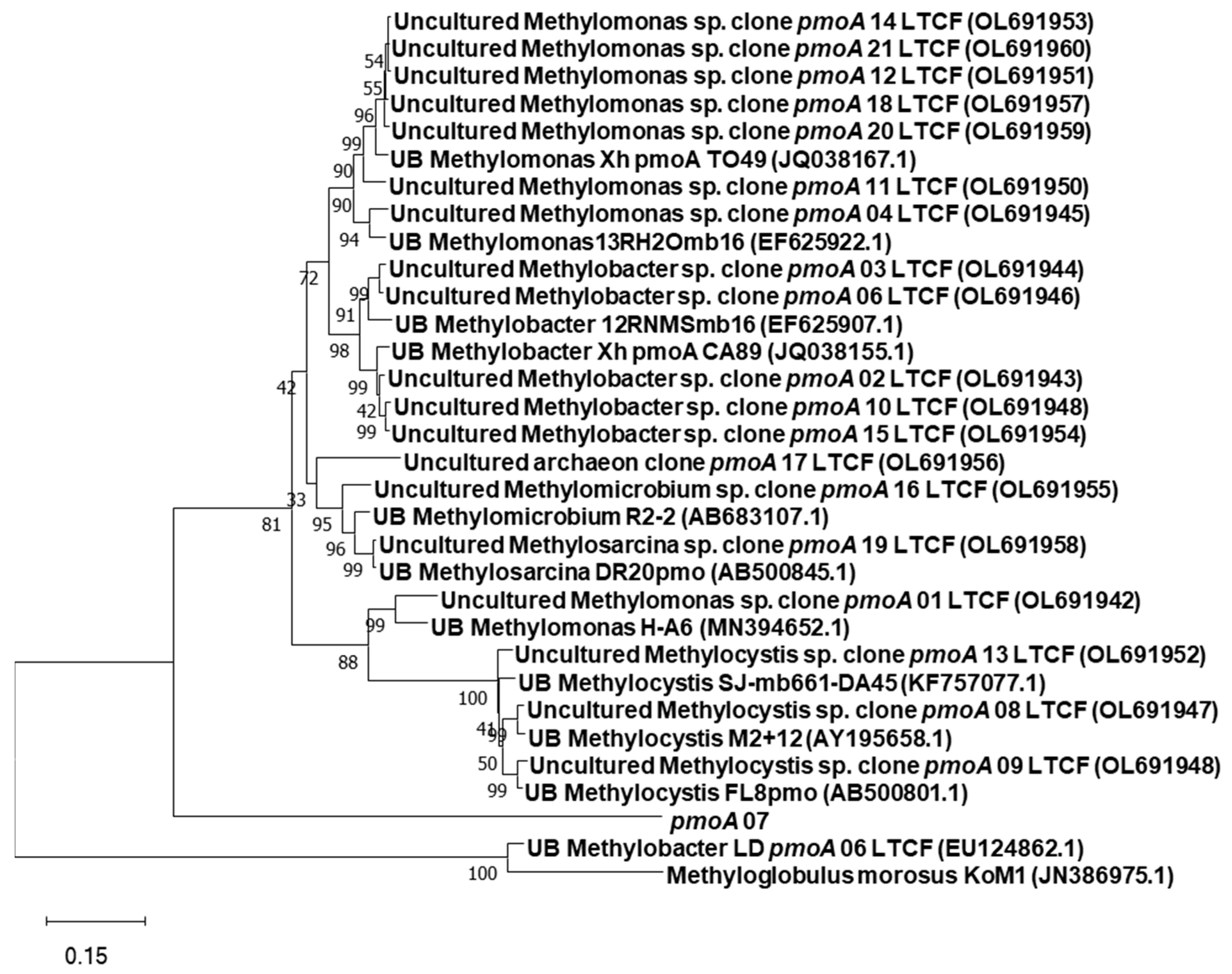Changes in Soil Chemical Properties Due to Long-Term Compost Fertilization Regulate Methane Turnover Related Gene Abundances in Rice Paddy
Abstract
:1. Introduction
2. Materials and Methods
2.1. Field Experimental Design and Soil Sampling
2.2. Determination of Soil Chemical Properties
2.3. DNA Extraction, PCR Amplification, Cloning, and Sequencing of Functional Genes
2.4. Quantitative PCR
2.5. Statistical Analysis
3. Results
4. Discussion
5. Practical Implications of the Study
6. Conclusions
Supplementary Materials
Author Contributions
Funding
Institutional Review Board Statement
Informed Consent Statement
Data Availability Statement
Acknowledgments
Conflicts of Interest
References
- Paustian, K.; Lehmann, J.; Ogle, S.; Reay, D.; Robertson, G.P.; Smith, P. Climate-smart soils. Nature 2016, 532, 49–57. [Google Scholar] [CrossRef] [PubMed] [Green Version]
- Burns, R.G.; Nannipieri, P.; Benedetti, A.; Hopkins, D.W. Defining soil quality. In Microbiological Methods for Assessing Soil Quality; Bloem, J., Hopkins, D.W., Benedetti, A., Eds.; CABI Publishing: Cambridge, UK, 2006; pp. 15–22. [Google Scholar]
- Schloter, M.; Nannipieri, P.; Sørensen, S.J.; van Elsas, J.D. Microbial indicators for soil quality. Biol. Fertil. Soils. 2018, 54, 1–10. [Google Scholar] [CrossRef] [Green Version]
- Le Mer, J.; Roger, P. Production, oxidation, emission and consumption of methane by soils: A review. Eur. J. Soil Biol. 2001, 37, 25–50. [Google Scholar] [CrossRef]
- Jackson, R.B.; Abernethy, S.; Canadell, J.G.; Cargnello, M.; Davis, S.J.; Féron, S.; Fuss, S.; Heyer, A.J.; Hong, C.; Jones, C.D.; et al. Atmospheric methane removal: A research agenda. Philos. Trans. R. Soc. A 2021, 379, 20200454. [Google Scholar] [CrossRef] [PubMed]
- Linquist, B.A.; Adviento-Borbe, M.A.; Pittelkow, C.M.; van Kessel, C.; van Groenigen, K.J. Fertilizer management practices and greenhouse gas emissions from rice systems: A quantitative review and analysis. Field Crops Res. 2012, 135, 10–21. [Google Scholar] [CrossRef]
- Carlson, K.M.; Gerber, J.S.; Mueller, N.D.; Herrero, M.; MacDonald, G.K.; Brauman, K.A.; West, P.C. Greenhouse gas emissions intensity of global croplands. Nat. Clim. Chang. 2017, 7, 63–68. [Google Scholar] [CrossRef]
- Conrad, R. Microbial ecology of methanogens and methanotrophs. Adv. Agron. 2007, 96, 1–63. [Google Scholar]
- Diacono, M.; Montemurro, F. Long-term effects of organic amendments on soil fertility. In Sustainable Agriculture; Lichtfouse, E., Hamelin, M., Navarette, M., Debaeke, P., Eds.; Springer: Berlin/Heidelberg, Germany, 2011; Volume 2, pp. 761–786. [Google Scholar]
- Yuan, J.; Yuan, Y.; Zhu, Y.; Cao, L. Effects of different fertilizers on methane emissions and methanogenic community structures in paddy rhizosphere soil. Sci. Total Environ. 2018, 627, 770–781. [Google Scholar] [CrossRef]
- Zhang, W.; Sheng, R.; Zhang, M.; Xiong, G.; Hou, H.; Li, S.; Wei, W. Effects of continuous manure application on methanogenic and methanotrophic communities and methane production potentials in rice paddy soil. Agric. Ecosyst. Environ. 2018, 258, 121–128. [Google Scholar] [CrossRef]
- Bhattacharyya, P.; Nayak, A.K.; Mohanty, S.; Tripathi, R.; Shahid, M.; Kumar, A.; Rao, K.S. Greenhouse gas emission in relation to labile soil C, N pools and functional microbial diversity as influenced by 39 years long-term fertilizer management in tropical rice. Soil Tillage Res. 2013, 129, 93–105. [Google Scholar] [CrossRef]
- Cai, Z.C.; Tsuruta, H.; Minami, K. Methane emission from rice fields in China: Measurements and influencing factors. J. Geophys. Res. Atmos. 2000, 105, 17231–17242. [Google Scholar] [CrossRef] [Green Version]
- Bodelier, P.L. Interactions between nitrogenous fertilizers and methane cycling in wetland and upland soils. Curr. Opin. Environ. Sustain. 2011, 3, 379–388. [Google Scholar] [CrossRef]
- Jiang, Y.; Qian, H.; Huang, S.; Zhang, X.; Wang, L.; Zhang, L.; Shen, M.; Xiao, X.; Chen, F.; Zhang, H.; et al. Acclimation of methane emissions from rice paddy fields to straw addition. Sci. Adv. 2019, 5, eaau9038. [Google Scholar] [CrossRef] [PubMed] [Green Version]
- Conrad, R.; Klose, M.; Noll, M.; Kemnitz, D.; Bodelier, P.L. Soil type links microbial colonization of rice roots to methane emission. Glob. Chang. Biol. 2008, 14, 657–669. [Google Scholar] [CrossRef]
- Lyu, Z.; Shao, N.; Akinyemi, T.; Whitman, W.B. Methanogenesis. Curr. Biol. 2018, 28, R727–R732. [Google Scholar] [CrossRef] [Green Version]
- Hakobyan, A.; Liesack, W. Unexpected metabolic versatility among type II methanotrophs in the Alphaproteobacteria. Biol. Chem. 2020, 401, 1469–1477. [Google Scholar] [CrossRef]
- Daquiado, A.R.; Kuppusamy, S.; Kim, S.Y.; Kim, J.H.; Yoon, Y.E.; Kim, P.J.; Lee, Y.B. Pyrosequencing analysis of bacterial community diversity in long-term fertilized paddy field soil. Appl. Soil Ecol. 2016, 108, 84–91. [Google Scholar] [CrossRef]
- Heczko, J.; Gselman, A.; Turinek, M.; Bavec, M.; Kristl, J. Organic carbon content in soils of long-term field trial: Comparison of analytical methods. Agricultura 2011, 8, 17–22. [Google Scholar]
- Bremner, J.M. Determination of nitrogen in soil by the Kjeldahl method. J. Agric. Sci. 1960, 55, 11–33. [Google Scholar] [CrossRef]
- Samaddar, S.; Truu, J.; Chatterjee, P.; Truu, M.; Kim, K.; Kim, S.; Sa, T. Long-term silicate fertilization increases the abundance of Actinobacterial population in paddy soils. Biol. Fertil. Soils 2019, 55, 109–120. [Google Scholar] [CrossRef]
- Jones, D.L.; Willett, V.B. Experimental evaluation of methods to quantify dissolved organic nitrogen (DON) and dissolved organic carbon (DOC) in soil. Soil Biol. Biochem. 2006, 38, 991–999. [Google Scholar] [CrossRef]
- Basic Local Alignment Search Tool. Available online: https://blast.ncbi.nlm.nih.gov/ (accessed on 10 September 2021).
- Tamura, K.; Stecher, G.; Peterson, D.; Filipski, A.; Kumar, S. MEGA6: Molecular evolutionary genetics analysis version 6.0. Mol. Biol. Evol. 2013, 30, 2725–2729. [Google Scholar] [CrossRef] [PubMed] [Green Version]
- Thompson, J.D.; Higgins, D.G.; Gibson, T.J. CLUSTAL W: Improving the sensitivity of progressive multiple sequence alignment through sequence weighting, position-specific gap penalties and weight matrix choice. Nucleic Acids Res. 1994, 22, 4673–4680. [Google Scholar] [CrossRef] [PubMed] [Green Version]
- Jukes, T.H.; Cantor, C.R. Evolution of protein molecules. In Mammalian Protein Metabolism; Academic Press: Cambridge, MA, USA, 1969; Volume 3, pp. 21–132. [Google Scholar]
- Saitou, N.; Nei, M. The neighbor-joining method: A new method for reconstructing phylogenetic trees. Mol. Biol. Evol. 1987, 4, 406–425. [Google Scholar]
- Felsenstein, J. Confidence limits on phylogenies: An approach using the bootstrap. Evolution 1985, 39, 783–791. [Google Scholar] [CrossRef] [PubMed]
- SAS Institute Inc. Base Sas 9.4 Procedures Guide: Statistical Procedures, 2nd ed.; SAS Institute: Cary, NC, USA, 2013. [Google Scholar]
- Metsalu, T.; Vilo, J. ClustVis: A web tool for visualizing clustering of multivariate data using Principal Component Analysis and heatmap. Nucleic Acids Res. 2015, 43, W566–W570. [Google Scholar] [CrossRef]
- Tang, Y.; Horikoshi, M.; Li, W. Ggfortify: Unified interface to visualize statistical results of popular R packages. R J. 2016, 8, 474. [Google Scholar] [CrossRef] [Green Version]
- Rohart, F.; Gautier, B.; Singh, A.; Lê Cao, K.A. mixOmics: An R package for ‘omics feature selection and multiple data integration. PLoS Comput. Biol. 2017, 13, e1005752. [Google Scholar] [CrossRef] [Green Version]
- Weiner, J.; Weiner, M.J. Package ‘pca3d’. 2020. Available online: http://www2.uaem.mx/r-mirror/web/packages/pca3d/pca3d.pdf (accessed on 25 September 2021).
- Zheng, J.; Zhang, X.; Li, L.; Zhang, P.; Pan, G. Effect of long-term fertilization on C mineralization and production of CH4 and CO2 under anaerobic incubation from bulk samples and particle size fractions of a typical paddy soil. Agric. Ecosyst. Environ. 2007, 120, 129–138. [Google Scholar] [CrossRef]
- Zheng, Y.; Zhang, L.M.; Zheng, Y.M.; Di, H.; He, J.Z. Abundance and community composition of methanotrophs in a Chinese paddy soil under long-term fertilization practices. J. Soils Sediments 2008, 8, 406–414. [Google Scholar] [CrossRef] [Green Version]
- Tang, H.M.; Xiao, X.P.; Wang, K.; Li, W.Y.; Liu, J.; Sun, J.M. Methane and nitrous oxide emissions as affected by long-term fertilizer management from double-cropping paddy fields in Southern China. J. Agric. Sci. 2016, 154, 1378–1391. [Google Scholar] [CrossRef]
- Guo, Z.; Han, J.; Li, J.; Xu, Y.; Wang, X. Effects of long-term fertilization on soil organic carbon mineralization and microbial community structure. PLoS ONE 2019, 14, e0211163. [Google Scholar]
- Kang, H.; Yu, W.; Dutta, S.; Gao, H. Soil microbial community composition and function are closely associated with soil organic matter chemistry along a latitudinal gradient. Geoderma 2021, 383, 114744. [Google Scholar] [CrossRef]
- Ma, L.; Lin-Zhang, Y.; Li-Zhong, X.; Ming-Xing, S.; Shi-Xue, Y.; Yun-Dong, L. Long-term effects of inorganic and organic amendments on organic carbon in a paddy soil of the Taihu Lake Region, China. Pedosphere 2011, 21, 186–196. [Google Scholar] [CrossRef]
- Pandey, A.; Dou, F.; Morgan, C.L.; Guo, J.; Deng, J.; Schwab, P. Modeling organically fertilized flooded rice systems and its long-term effects on grain yield and methane emissions. Sci. Total Environ. 2021, 755, 142578. [Google Scholar] [CrossRef] [PubMed]
- Zhang, H.M.; Wang, B.; Xu, M.; Fan, T. Crop yield and soil responses to long term fertilization on a red soil in southern China. Pedosphere 2009, 19, 199–207. [Google Scholar] [CrossRef]
- Das, S.; Adhya, T.K. Effect of combine application of organic manure and inorganic fertilizer on methane and nitrous oxide emissions from a tropical flooded soil planted to rice. Geoderma 2014, 213, 185–192. [Google Scholar] [CrossRef]
- Kong, D.; Li, S.; Jin, Y.; Wu, S.; Chen, J.; Hu, T.; Wang, H.; Liu, S.; Zou, J. Linking methane emissions to methanogenic and methanotrophic communities under different fertilization strategies in rice paddies. Geoderma 2019, 347, 233–243. [Google Scholar] [CrossRef]
- Lee, H.J.; Kim, S.Y.; Kim, P.J.; Madsen, E.L.; Jeon, C.O. Methane emission and dynamics of methanotrophic and methanogenic communities in a flooded rice field ecosystem. FEMS Microbiol. Ecol. 2014, 88, 195–212. [Google Scholar] [CrossRef]
- Freitag, T.E.; Toet, S.; Ineson, P.; Prosser, J.I. Links between methane flux and transcriptional activities of methanogens and methane oxidizers in a blanket peat bog. FEMS Microbiol. Ecol. 2010, 73, 157–165. [Google Scholar] [CrossRef]
- Fernández-Baca, C.P.; Truhlar, A.M.; Omar, A.E.H.; Rahm, B.G.; Walter, M.T.; Richardson, R.E. Methane and nitrous oxide cycling microbial communities in soils above septic leach fields: Abundances with depth and correlations with net surface emissions. Sci. Total Environ. 2018, 640, 429–441. [Google Scholar] [CrossRef] [PubMed]
- Hou, P.; Yu, Y.; Xue, L.; Petropoulos, E.; He, S.; Zhang, Y.; Pandey, A.; Xue, L.; Yang, L.; Chen, D. Effect of long term fertilization management strategies on methane emissions and rice yield. Sci. Total Environ. 2020, 725, 138261. [Google Scholar] [CrossRef] [PubMed]
- Qin, Y.; Liu, S.; Guo, Y.; Liu, Q.; Zou, J. Methane and nitrous oxide emissions from organic and conventional rice cropping systems in Southeast China. Biol. Fertil. Soils 2010, 46, 825–834. [Google Scholar] [CrossRef]
- Mohanty, S.R.; Bodelier, P.L.; Floris, V.; Conrad, R. Differential effects of nitrogenous fertilizers on methane-consuming microbes in rice field and forest soils. Appl. Environ. Microbiol. 2006, 72, 1346–1354. [Google Scholar] [CrossRef] [Green Version]
- Cai, Y.; Zheng, Y.; Bodelier, P.L.; Conrad, R.; Jia, Z. Conventional methanotrophs are responsible for atmospheric methane oxidation in paddy soils. Nat. Commun. 2016, 7, 11728. [Google Scholar] [CrossRef] [Green Version]
- Fey, A.; Conrad, R. Effect of temperature on carbon and electron flow and on the archaeal community in methanogenic rice field soil. Appl. Environ. Microbiol. 2000, 66, 4790–4797. [Google Scholar] [CrossRef] [Green Version]
- Lueders, T.; Friedrich, M. Archaeal population dynamics during sequential reduction processes in rice field soil. Appl. Environ. Microbiol. 2000, 66, 2732–2742. [Google Scholar] [CrossRef] [Green Version]
- Lueders, T.; Chin, K.J.; Conrad, R.; Friedrich, M. Molecular analyses of methyl-coenzyme M reductase α-subunit (mcrA) genes in rice field soil and enrichment cultures reveal the methanogenic phenotype of a novel archaeal lineage. Environ. Microbiol. 2001, 3, 194–204. [Google Scholar] [CrossRef]
- Bao, Q.; Huang, Y.; Wang, F.; Nie, S.; Nicol, G.W.; Yao, H.; Ding, L. Effect of nitrogen fertilizer and/or rice straw amendment on methanogenic archaeal communities and methane production from a rice paddy soil. Appl. Microbiol Biotechnol. 2016, 100, 5989–5998. [Google Scholar] [CrossRef]
- Kim, S.Y.; Pramanik, P.; Bodelier, P.L.; Kim, P.J. Cattle manure enhances methanogens diversity and methane emissions compared to swine manure under rice paddy. PLoS ONE 2014, 9, e113593. [Google Scholar] [CrossRef] [Green Version]
- Henckel, T.; Friedrich, M.; Conrad, R. Molecular analyses of the methane-oxidizing microbial community in rice field soil by targeting the genes of the 16S rRNA, particulate methane monooxygenase, and methanol dehydrogenase. Appl. Environ. Microbiol. 1999, 65, 1980–1990. [Google Scholar] [CrossRef] [PubMed] [Green Version]
- Bodelier, P.L.; Roslev, P.; Henckel, T.; Frenzel, P. Stimulation by ammonium-based fertilizers of methane oxidation in soil around rice roots. Nature 2000, 403, 421–424. [Google Scholar] [CrossRef] [PubMed]
- Alam, M.S.; Jia, Z. Inhibition of methane oxidation by nitrogenous fertilizers in a paddy soil. Front. Microbiol. 2012, 3, 246. [Google Scholar] [CrossRef] [Green Version]
- Kim, C.; Walitang, D.I.; Sa, T. Methanogenesis and methane oxidation in paddy fields under organic fertilization. Korean J. Environ. Agric. 2021, 40, 295–312. [Google Scholar] [CrossRef]
- Steinberg, L.M.; Regan, J.M. Phylogenetic comparison of the methanogenic communities from an acidic, oligotrophic fen and an anaerobic digester treating municipal wastewater sludge. Appl. Environ. Microbiol. 2008, 74, 6663–6671. [Google Scholar] [CrossRef] [Green Version]
- Poulsen, M.; Schwab, C.; Jensen, B.B.; Engberg, R.M.; Spang, A.; Canibe, N.; Urich, T. Methylotrophic methanogenic Thermoplasmata implicated in reduced methane emissions from bovine rumen. Nat. Commun. 2013, 4, 1428. [Google Scholar] [CrossRef] [Green Version]
- Costello, A.M.; Lidstrom, M.E. Molecular characterization of functional and phylogenetic genes from natural populations of methanotrophs in lake sediments. Appl. Environ. Microbiol. 1999, 65, 5066–5074. [Google Scholar] [CrossRef] [Green Version]



| Parameter | DF | Sum of Squares | Mean Square | F Value | Pr > F | Number of Observations |
|---|---|---|---|---|---|---|
| pH | 4 | 0.529 | 0.132 | 7.91 | 0.0350 | 9 |
| EC | 4 | 0.196 | 0.049 | 0.15 | 0.9513 | 9 |
| OM | 4 | 1.149 | 0.287 | 15.41 | 0.0107 | 9 |
| TN | 4 | 0.009 | 0.002 | 43.01 | 0.0015 | 9 |
| P2O5 | 4 | 20640 | 5160 | 55.52 | 0.0009 | 9 |
| K | 4 | 0.298 | 0.075 | 43.16 | 0.0015 | 9 |
| Ca | 4 | 4.989 | 1.247 | 6.58 | 0.0476 | 9 |
| Mg | 4 | 0.662 | 0.167 | 3.95 | 0.1060 | 9 |
| DOC | 4 | 3926 | 981.5 | 6.89 | 0.0441 | 9 |
| Treatment | pH | EC | OM | TN | P2O5 | K | Ca | Mg | DOC | mcrA | pmoA |
|---|---|---|---|---|---|---|---|---|---|---|---|
| (1:5) | (dS m−1) | (%) | (%) | (mg kg−1) | (cmol kg−1) | (mg kg−1) | Copy Number g−1 Dry Soil | ||||
| NF | 5.80 ab | 0.90 a | 2.1 b | 0.15 b | 28 c | 0.13 b | 5.7 b | 1.13 b | 53 b | 1.20 × 106 b | 1.60 × 106 b |
| NPKCom | 5.99 a | 1.23 a | 2.9 a | 0.22 a | 141 a | 0.53 a | 7.3 a | 1.71 a | 74 ab | 3.47 × 106 a | 4.08 × 106 a |
| Com | 5.64 b | 1.09 a | 2.7 a | 0.21 a | 63 b | 0.49 a | 6.5 ab | 1.22 b | 99 a | 3.42 × 106 a | 4.31 × 106 a |
| Principal Component | Eigenvalues | Component Loading | Cumulative Loading | ||||||||
|---|---|---|---|---|---|---|---|---|---|---|---|
| 1 | 6.851 | 0.6228 | 0.6228 | ||||||||
| 2 | 1.859 | 0.1690 | 0.7918 | ||||||||
| 3 | 1.144 | 0.1040 | 0.8957 | ||||||||
| 4 | 0.778 | 0.0708 | 0.9665 | ||||||||
| 5 | 0.172 | 0.0156 | 0.9821 | ||||||||
| 6 | 0.160 | 0.0146 | 0.9967 | ||||||||
| 7 | 0.027 | 0.0025 | 0.9991 | ||||||||
| 8 | 0.009 | 0.0009 | 1.0000 | ||||||||
| Principal component loading for each variable | |||||||||||
| mcrA | pmoA | pH | EC | OM | TN | P2O5 | K | Ca | Mg | DOC | |
| PC1 | 0.324 | 0.329 | 0.055 | 0.207 | 0.353 | 0.369 | 0.316 | 0.361 | 0.337 | 0.302 | 0.214 |
| PC2 | −0.049 | −0.234 | 0.660 | −0.068 | −0.115 | −0.134 | 0.223 | −0.070 | 0.292 | 0.370 | −0.441 |
| PC3 | 0.129 | −0.356 | −0.185 | 0.761 | −0.065 | −0.126 | −0.240 | −0.229 | 0.147 | 0.288 | 0.090 |
Publisher’s Note: MDPI stays neutral with regard to jurisdictional claims in published maps and institutional affiliations. |
© 2022 by the authors. Licensee MDPI, Basel, Switzerland. This article is an open access article distributed under the terms and conditions of the Creative Commons Attribution (CC BY) license (https://creativecommons.org/licenses/by/4.0/).
Share and Cite
Kim, C.; Walitang, D.I.; Roy Choudhury, A.; Lee, Y.; Lee, S.; Chun, H.; Heo, T.-Y.; Park, K.; Sa, T. Changes in Soil Chemical Properties Due to Long-Term Compost Fertilization Regulate Methane Turnover Related Gene Abundances in Rice Paddy. Appl. Sci. 2022, 12, 2652. https://doi.org/10.3390/app12052652
Kim C, Walitang DI, Roy Choudhury A, Lee Y, Lee S, Chun H, Heo T-Y, Park K, Sa T. Changes in Soil Chemical Properties Due to Long-Term Compost Fertilization Regulate Methane Turnover Related Gene Abundances in Rice Paddy. Applied Sciences. 2022; 12(5):2652. https://doi.org/10.3390/app12052652
Chicago/Turabian StyleKim, Chungwoo, Denver I. Walitang, Aritra Roy Choudhury, Yi Lee, Sanghun Lee, Hyenchung Chun, Tae-Young Heo, Kido Park, and Tongmin Sa. 2022. "Changes in Soil Chemical Properties Due to Long-Term Compost Fertilization Regulate Methane Turnover Related Gene Abundances in Rice Paddy" Applied Sciences 12, no. 5: 2652. https://doi.org/10.3390/app12052652
APA StyleKim, C., Walitang, D. I., Roy Choudhury, A., Lee, Y., Lee, S., Chun, H., Heo, T.-Y., Park, K., & Sa, T. (2022). Changes in Soil Chemical Properties Due to Long-Term Compost Fertilization Regulate Methane Turnover Related Gene Abundances in Rice Paddy. Applied Sciences, 12(5), 2652. https://doi.org/10.3390/app12052652







